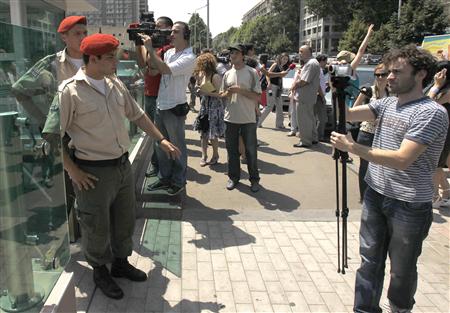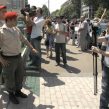
Photographers’ Case In Tbilisi: Five Misconceptions
Publication: Eurasia Daily Monitor Volume: 8 Issue: 135
By:

Georgian media-freedom watchdogs, criticizing the espionage investigation against three local photographers (“Three Photographers Charged With Espionage In Georgia,” EDM, July 14), have crossed the line beyond their own mandate. This group now seeks publication of the classified evidence and an “independent review” of the case with their own participation, all this ahead of the court trial.
A delegation of watchdogs and opposition journalists presented these demands to Internal Affairs Minister, Vano Merabishvili, on July 13 in a three-hour long meeting. The delegation left dissatisfied over issues unrelated to journalism or media freedom. They wanted the court to authorize the defense lawyers to share the classified information “with the people.” They felt that the evidence presented to them in the espionage case did not substantiate the charges. They sought “additional proof” and claimed that it was not forthcoming to their satisfaction. They demanded “public scrutiny” into the substance of the espionage case. And they rejected Merabishvili’s offer to share some additional evidence with them in return for a pledge of confidentiality on their part (Rustavi-2 TV, July 12; EurasiaNet, Civil Georgia, July 13).
Irrespective of merits or demerits of the espionage charges, five misconceptions are common in much of the reporting by Georgian and international media.
A first misconception suggests that this investigation might serve to intimidate Georgian media and the journalistic profession, allegedly signaling dangers to their independence. This reasoning seems a non sequitur, however, since the investigation is unrelated to any journalistic or political activity. Some claim (Kavkaz-Press, July 11) that the three photographers may have displeased the authorities by disseminating images of the May 26 police dispersal of violent rioters in Tbilisi (see EDM, May 24, 26, 27) to international news agencies. This inference seems designed to politicize a non-political, state-security case. But the inference also seems gratuitous, considering that images of the May 26 incident became widely and instantly available through the Internet, from Georgian and international sources.
Second, the photographers involved are often described inaccurately as accused journalists (or at least “photojournalists”); and local critics depict the investigation as interfering with the free operation of mass media. However, Irakli Gedenidze and Giorgi Abdaladze had the status of employees of state institutions, not journalists, at the time of their alleged wrongdoings (Abdaladze had also worked part-time as photographer for the opposition press). The investigation pertains only to their activities while performing state service, unrelated to journalism or mass media. The alleged photographing of documents stamped “classified” for sending abroad would seem to indicate (if proved in court) a case of indirect Russian penetration of Georgian state institutions. Meanwhile, hardly a mention is made of Zurab Kurtsikidze, the principal accused in the case, pending the start of court proceedings on September 1.
The third misconception holds that the pre-trial investigation must be fully open, and the trial public, in order to dispel concerns about restrictions on media freedom. This idealistic view, however, would be hard to reconcile with proceedings that involve examination of classified documents and the risk of openly provoking Russia. In 2006, Georgian authorities detained and sentenced four Russian GRU officers, with adequate publicity. An infuriated Moscow retaliated with the embargo (which continues to the present day) on Georgian wines and other products. Georgia’s Western partners reproached Tbilisi for unduly provoking Moscow by publicizing that espionage case. Considering that experience, Georgian authorities today are notably cautious about a public trial in the ongoing case. The prosecution can agree with opening the trial to the public, provided that the classified parts of the evidence that contain state secrets are examined in closed sessions of the court (EurasiaNet, July 13).
Fourth, the reporting overlooks the implications of the alleged interest in details of president Saakashvili’s building layout and his logistics. This directly concerns his physical safety. His predecessor in office, Eduard Shevardnadze, had been the target of two assassination attempts organized in Russia and openly welcomed by Moscow’s official establishment at that time. During Saakashvili’s tenure, at least one prominent Russian state television presenter and one top consultant to the Kremlin alluded to the desirability of assassinating Saakashvili (“one bullet could resolve this problem”), well before the August 2008 invasion of Georgia. After that invasion, which fell short of forcing regime-change, Russian Prime Minister Vladimir Putin spoke publicly about hanging the Georgian president.
The fifth, and latest, misconception holds that NGOs, journalists and media freedom watchdogs, and potentially other outside parties ought to conduct an “independent” investigation into the substance of the case, have the evidence declassified ahead of the trial, review it and share it with the public. This latest set of demands would (if ever considered) erase institutional competencies and jurisdictions; intrude into law-enforcement’s responsibilities ranging from counter-intelligence to administration of justice, and turn due process of law into a populist exercise. It reflects the immaturity of much of the opposition press, which is one of the under-reported challenges to development of modern mass media in Georgia.




